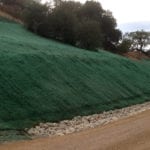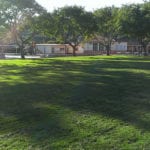Hydroseeding
Whether you would like to install an area of turf, drought tolerant lawn alternative, or encourage the growth of native shrubs and grasses to stabilize a slope, Hydroseeding, Hydromulching and Drill Seeding can be cost-effective approaches for planting and securing large areas with minimal disturbance to the soil.
Hydroseeding
Hydroseeding involves the application of a homogeneous slurry of water, seed, wood fiber mulch, and soil stabilizing tackifier to prevent soil erosion and provide an environment conducive to plant growth. The process is called Hydromulching when no seed is added to the mixture. These mixtures are applied using a truck-mounted tank equipped with a special pump and continuous agitation system. The slurry is pumped through a top-mounted discharge nozzle or by hose over a distance of 300 feet or more.
This method applies a protective layer over the soil that resists erosion while creating an optimum environment for plant growth. Hydromulching and Hydroseeding promote soil health by minimizing soil disturbance and helping with moisture retention. The Hydroseed mixture can also be supplemented with amendments such as organic fertilizer or mycorrhiza fungi for resilient, healthy plants.
Applications:
- Temporary or permanent erosion control measure
- Turf planting
- Native grasses and lawn alternatives
- Meadow and wildflower planting
- Spreading tackifier and seed over rice straw or netting
Benefits of Hydromulching and Hydroseeding:
- Provides a layer of protection from erosion with wood fiber mulch and organic glue
- Cost effective approach for large scale or difficult of access sites
- Can be applied to steep slopes with minimal soil disturbance
- Consistent mixture of seed held in place even on steep slopes
- Retains moisture to encourage the germination of planted or existing seeds
- Can be supplemented with mycorrhiza fungi or organic fertilizer
Hydroseeding as Erosion Control
Temporary:
Hydromulch can be applied on its own or is often applied over rice straw to tack it down for increased protection. Hydromulching is often recommended for temporary protection during the rainy season to be landscaped later. This method provides protection from soil displacement by raindrops and acts as a layer of mulch to encourage the germination of applied or existing seeds. Hydromulching without seed will provide temporary erosion control for one season.
Permanent:
Adding seed to Hydromulch, or Hydroseeding, will extend the erosion control duration and efficacy as the seeds germinate and take root, providing long term cover over bare soil. Hydroseed can be applied over a layer of rice straw, compost or netting for increased stabilization.
A number of variables might determine the success of seeds once they are distributed including precipitation, soil conditions, and severity of the slope. To mimic the natural succession of plant varieties that will aid in stabilizing slopes, a typical native erosion control seed mix contains a small number of annual seeds for a quick cover, a variety of perennial grasses and forbs indigenous to the area and often nurse crops that can provide protection for surrounding vegetation for the first year.
Hydroseeding as Landscaping:
Hydroseeding provides a method of quickly applying an even distribution of seed over a large area, ideal for the planting of turf grasses or lawn alternatives. Lawn alternatives include native grasses, drought-tolerant fescues, shrubs, and wildflowers. Applications can be supplemented with mycorrhiza fungi or fertilizer to encourage optimum growth and treat depleted soil.
Drill Seeding
A drill seeder is used to sow seeds under the surface of the soil. This method is typically used on slopes 3:1 and flatter, and in areas easily accessible by large equipment. Drill seeding improves conditions for seed germination by inserting seeds directly into the soil in concentrated rows, increasing contact with soil and moisture. The Drill Seeder opens the soil surface in equally spaced furrows. Seeds are then dropped from a seedbox into the furrows and soil is packed firmly around the seed with a press wheel. The spacing achieved with a drill seeder can give the desired species a competitive advantage so that it may flourish if other plants are already established. Drill Seeding requires lower seed application rates than other mass broadcasting methods such as Hydroseeding or Dry Seed.
To prevent surface erosion after drilling seed, consider following this treatment with:
Hydromulch
Mulch
Local Topsoil
Compost


